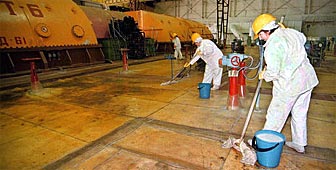
The fall-out from Chernobyl is still being felt

The Chernobyl nuclear power station in Ukraine, scene of the world's worst nuclear disaster in April 1986, is set to close on Friday. Nearly 15 years later, its effects continue to be felt in other parts of Europe, including Switzerland.
On the night of the explosion, radiation over 100 times higher than that caused by the two atomic bombs dropped on Hiroshima and Nagasaki was released into the atmosphere. It sent a radioactive plume across wide areas of Europe.
“It was a unique event in human history, and I must stress, we cannot afford to forget about it,” says Dusan Zupka, manager of the United Nations programme on Chernobyl.
The problem is that, while the international community responded generously to the Chernobyl disaster at the time, other catastrophes have since intervened.
“This makes things very difficult for us. At the UN we face new disasters almost daily, but Chernobyl is a continuing catastrophe, so our response must continue too.” Zupka told swissinfo
But of almost 60 aid programmes approved by the UN to the Chernobyl region, only nine identified as high priority have the funding to proceed. Zupka says the true scale of the disaster is only now becoming apparent.
“Every area of life is affected – from human health, to the environment, to the economy, to social infrastructure.”
In Switzerland, the authorities share Zupka’s concern over the lack of long-term support for the Chernobyl region.
Hans Peter Maag, head of the former Soviet Union section at the Swiss Development Corporation, said: “The fact that the disaster has taken place doesn’t mean that the problem is over. In a case like Chernobyl there is long term contamination, and very little knowledge about the effects of such contamination.”
The Corporation supports a number of Chernobyl-related projects in Ukraine, including a technical programme for increased nuclear safety, and a health programme for families who live in the contaminated areas.
“We run therapy camps for around 1,000 children a year,” says Maag. “They are taken out of the affected region into a clean environment. Medical treatment is provided if they need it. In addition we offer two to three weeks in a sanatorium for mothers and children from the worst affected regions.”
Although the incidence of thyroid cancer and leukaemia are already higher in the areas around Chernobyl, scientists believe the full effects of the disaster may not be known for another 20 years.
Staff at Basel’s Friedrich Miescher Institute have made grim discoveries in the exclusion zone around the damaged reactor.
Visiting research scientist, Igor Kovalchuk, who examined the incidence of genetic mutation among plants in the zone, said: “We started with small wild plants and then moved on to more important crops like wheat, oats, and barley. We found that the number of genetically mutated plants was six times higher than we had expected it to be.”
One of the tragic by-products of Chernobyl is the opportunity it has provided for scientists like Kovalchuk to study the effects of long term radiation.
“We can’t simulate something like Chernobyl in the laboratory. Exposing plants to short but strong bursts of radiation is not the same. So, unfortunate though it is, we are learning from Chernobyl.”
For the time being, Kovalchuk is not concerned about the effects on human health of the genetically mutated plants around Chernobyl.
“It won’t affect humans quite simply because no one is allowed in that zone. The radioactivity is so high that I expect that area to be closed for thousands of years.”
But, across vast areas of Ukraine, Belarus and Russia, millions of people are still living with the effects of Chernobyl.
The region used to be known as the bread basket of the Soviet Union: now there is no market for the food it used to export. Even its once valuable timber can no longer be used to make furniture because no one wants to buy it.
“Unemployment and economic collapse is another long-term consequence of Chernobyl,and another reason why we really cannot afford to neglect this region,” sasys Zupka.
The closure on Friday of Chernobyl’s last remaining nuclear reactor will have another negative impact. The reactor provided five per cent of Ukraine’s electricity, so, as winter approaches there will probably be power shortages.
And several thousand people who worked at the reactor will also join the already swollen ranks of Ukraine’s unemployed.
by Imogen Foulkes.

In compliance with the JTI standards
More: SWI swissinfo.ch certified by the Journalism Trust Initiative





























You can find an overview of ongoing debates with our journalists here . Please join us!
If you want to start a conversation about a topic raised in this article or want to report factual errors, email us at english@swissinfo.ch.